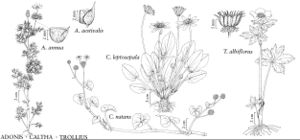Difference between revisions of "Trollius albiflorus"
Mem. New York Bot. Gard. 1: 152. 1900.
FNA>Volume Importer |
imported>Volume Importer |
||
| Line 61: | Line 61: | ||
|publication year=1900 | |publication year=1900 | ||
|special status=Endemic;Illustrated | |special status=Endemic;Illustrated | ||
| − | |source xml=https:// | + | |source xml=https://bibilujan@bitbucket.org/aafc-mbb/fna-data-curation.git/src/bb6b7e3a7de7d3b7888a1ad48c7fd8f5c722d8d6/coarse_grained_fna_xml/V3/V3_516.xml |
|genus=Trollius | |genus=Trollius | ||
|species=Trollius albiflorus | |species=Trollius albiflorus | ||
Revision as of 23:02, 27 May 2020
Stems 0.7-5.5 dm (to 8dm in fruit), base with few petioles persistent from previous year. Leaves: basal leaves with petioles 4-25 cm, some leaves reduced to sessile, ovate membranous scales; cauline leaves 1-3(-5), with broad, clasping, membranous sheaths. Flowers 2.5-5 cm diam.; sepals 5-9, spreading, white when fresh (pale yellow to greenish white before anthesis), ovate to obovate or nearly orbiculate, 10-20 mm; petals 15-25, yellow, 1/2-2/3 length of stamens when pollen shed, 3-6 mm. Follicles usually 11-14, 8-16 mm including beak; beak often somewhat recurved, sometimes straight. 2n=16.
Phenology: Flowering summer.
Habitat: Open, wet places, ±acidic, montane to alpine
Elevation: 1200-3800 m
Distribution

Alta., B.C., Colo., Idaho, Mont., Utah, Wash., Wyo.
Discussion
The diploid Trollius albiflorus is isolated from the tetraploid T. laxus ecologically, geographically, and reproductively, although it often has been treated as a variety of the latter.
Identities of specimens of Trollius albiflorus and the superficially similar Anemone narcissiflora subsp. zephyra in Colorado and Wyoming are sometimes confused. Close examination reveals a number of differences. The anemone has sepals yellow (not white), leaf blades and flowering stems pilose to villous (not glabrous), achenes (not follicles), and leaflike bracts subtending the pedicels and whorled (leaves alternate in Trollius).
Selected References
None.
